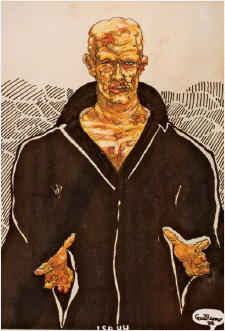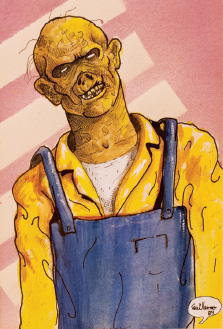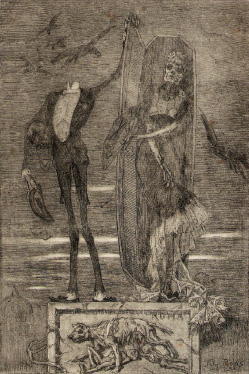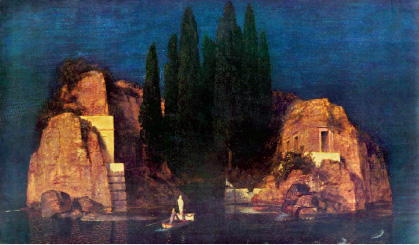GDT: No, no. I did all the doodles, and all the little balls and sticks and all that stuff, in black and white. But color was very important because I’m very attracted to color, instinctively.
MSZ: So when you first started working with color, was it with crayons or markers?
GDT: I’ve always hated crayons because I hate the texture. What I did with crayons was eat them, like every kid. I loved the taste of crayons when I was a kid. But I always drew with colored pencils. I find them very soft. Now, if I had the time, I would do alcohol markers all the time because that’s such a gentle medium.
MSZ: And where did you get your color sense from? It’s very strong.
GDT: I think it’s expressive. The colors of youth are gold, blue, and white. Those are the colors of hope and untainted promise. Then, to me, cyan is always a very subterranean color. And death is black, revenge is red, and tarnished gold or blue for memories. But it varies from picture to picture. They all dictate their own palette.
I taught myself to mix colors because I started painting models when I was a very young kid. So I was assembling models, all these monsters.
Part of me dreams of what would have been if I had become an illustrator. There is a saying, “Those who can’t draw, render.” And I can’t draw. I really am a self-taught guy, so my drawings are very deficient, and the way you mask a deficiency in a drawing is by overrendering, so what you see in the notebooks are not very good drawings.
MSZ: You’re really skilled, though. Did you ever take classes as a kid?
GDT: Well, the ones at school. But I was always drawing the wrong things, so I never got good grades on that, because they always found the subjects objectionable. For example, they would say, “Choose a moment in the life of this president and make it in clay.” And I would do the president when he was shot in the head, with blood on the table.
When some people saw my drawings and my paintings, they told my mother, “You’ve got to take this kid to a psychologist.” And she took me to a psychologist, and the guy gave me some clay and he said, “Do whatever you want.” And I did a skeleton. And then I asked the psychologist, “What does ‘bastard’ mean?” That didn’t help my case.
But I was truly—I mean, I knew stuff when I was a kid that I just don’t know how I knew. There are proclivities in my life that I just don’t try to understand.


Drawings by del Toro from his early twenties.
GUILLERMO’S MUSINGS ON SYMBOLIST ART
I HAVE ALWAYS BEEN partial to the symbolist and Pre-Raphaelite artists, because they go against the avant-garde. To them, the past was a source of awe and mystery. But unlike the Pre-Raphaelites, the symbolists also cast their gaze inward to find the root of the stain on the human soul: lust, violence, corruption. They connect our human impulses—good and bad—with the mystical, mythical, and supernatural elements that represent them in art (for example, satyrs, skulls, centaurs, demons) and in that they are, in my opinion, truly modern and timeless.
There are a few key words to understand the symbolist movement: paganism, mysticism, Romanticism, and decadence. Not all artists in the movement share these in equal measure. Félicien Rops fits decadence perfectly, Carlos Schwabe embodies paganism quite well, Redon tended toward mysticism, and Arnold Böcklin ascribed, without a doubt, to Romanticism.
I first became aware of the symbolist movement through a Mexican artist who was not exactly a contemporary of Rops, but rather a spiritual twin: Julio Ruelas (1870–1907), a multitalented artist obsessed with two of the symbolists’ staple themes: sex and death. In the late 1970s, while walking through a flea market in Puebla, Mexico, an art book with a startling cover caught my eye: a forensically detailed oil painting of a drowned satyr being pulled out of a river. Its body was purplish and bloated and its tongue hung loosely to the side. The book was Teresa del Conde’s monograph on Ruelas, which to this day is the best, if not the only, authoritative source of Ruelas lore.
Although he is not formally considered part of the school, Ruelas is a bona fide symbolist and his work seems heavily influenced by Rops, to the point that they share some shockingly similar vignettes and tend to gravitate toward a consistent array of imagery and themes: blind faith, Circe, satyrs, Socrates.

The Supreme Vice (1883) by Félicien Rops.
FÉLICIEN ROPS (1833–1898)
I was first exposed to Rops when in Cannes promoting Cronos in 1993. A young French critic urged me to seek him out so, while staying in a crappy hotel in Paris, I bought a book or two on Rops and was blown away by his sensibility.
The similarities between Rops and Ruelas made it all click for me. The nineteenth century was a period of enormous moral contrast. Nobility, honor, and good manners, all of which were supported by the “academic” art of the age, started to be sabotaged by a wild and perverse notion: that life was full of pagan pleasures and savage impulses. Our flesh made us weaker, yes, but it also made us human.
Sex for these artists is a savage, almost demonic, task. And none of them is more accurate in portraying the hopelessness of male desire than Rops. In his paintings are abundant, detailed, and deformed genitalia that stand side by side with images of death, evil, and decay. Like his century, Rops was a prisoner of dread and desire.
It is a fact that sex and politics go hand in hand, and Rops was also blessed with a sharp satirical eye that yielded some of the best political cartoons of the time—all of them mordant portrayals of the changing social climate. Incessantly drawing, etching, and painting, Rops strived to capture a “tainted” century where the entitlements of royalty and the excuses of nobility were about to be supplanted by more mundane rights and ambitions.
Savage and sensuous as his themes may be, Rops’s line work is supremely elegant—even exquisite. His use of drypoint is testament to the precision of his draftsmanship.
ARNOLD BÖCKLIN (1827–1901)
Bocklin’s treatment of light has always fascinated me. The way he captures the soft, dying sunlight and uses it to cast deep, ominous shadows in his forests and rocky outcrops is exquisite. The jewel-like quality that his overcast skies confer to the green ocean waves is mesmerizing.

Isle of the Dead (1880) by Arnold Böcklin.
Böcklin’s superb technique makes his creatures and landscapes seem absolutely real. Hooves, roots, glazed eyes, and fur all appear to be accurate depiction of actual, living things. Look at any of his beasts and you will see that their eyes are wild and stunned by instinct, their bodies sensual but animalistic, their mouths agape and lubricated. They all have the strength and savagery that I associate with Arthur Machen, Algernon Blackwood, and—in the case of Böcklin’s sea creatures—with H. P. Lovecraft.
If Rops excelled at portraying the human form, then Böcklin is the single most gifted landscape artist of the symbolist movement and the best at creating a sense of atmosphere. Böcklin’s landscapes are characters themselves—full of dramatic gloom, trees, rocks, and seas that reek of antiquity. In his most famous painting, Isle of the Dead (1880), for example, the darkness in his woods lurks like a sentient creature and the majestic vertical rocks and cypresses form a perfect mausoleum. It’s no wonder his painting was “paraphrased” by another Swiss artist almost a century later: H. R. Giger.